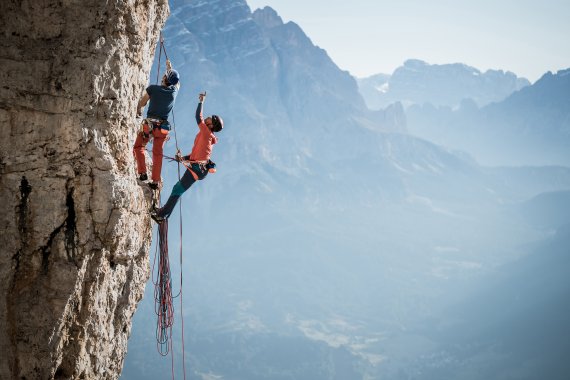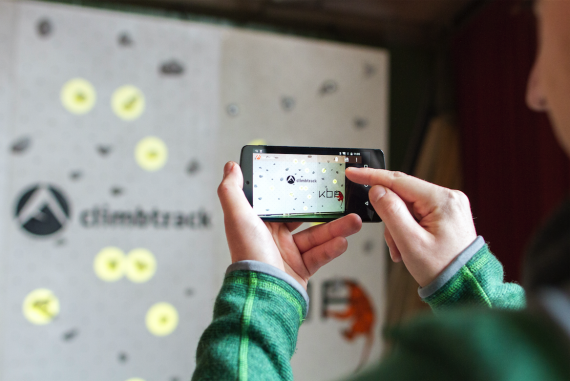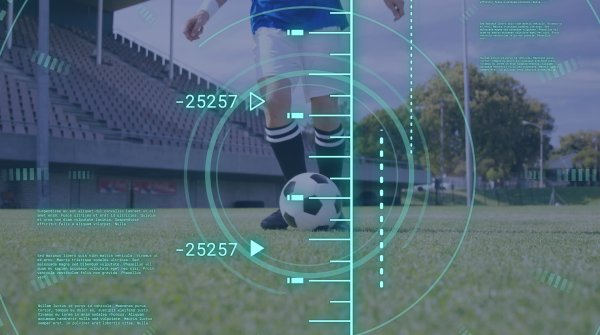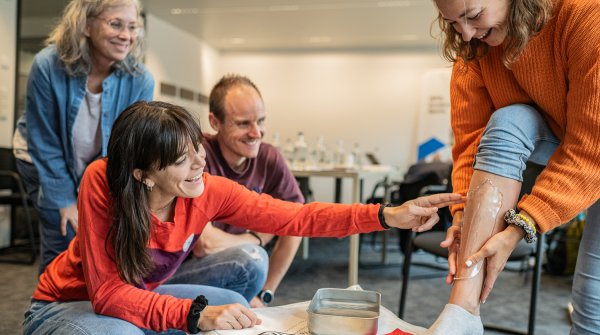
“With our intelligent climbing grips, we record the forces exerted by a climber and analyze them using machine learning,” says Fabian Weise. The computer science student is working with physics PhD student Jonathan Becker and the competitive climber Alexander Averdunk on the concept, which is still in the test phase. The technology is intended to help beginners to prevent injuries through targeted instruction. Professionals can optimize their performance through precise training. Efficient training plans are to be generated from the learned movement sequences, and even overloads are to be recognized during the training.
“It’s the first time that climbing is meeting artificial intelligence,” says Weise. Among others, the team is cooperating with professional climber Alexander Megos part of Germany’s 2020 Olympic squad. The new technology can be poured into any climbing handle. “New technologies are going to push the boundaries of top-class sports even further upwards,” says Fabian Weise. The intelligent grips can already be tried out in the climbing hall in Nuremberg.
With VR goggles, users can dive into another reality. Applied to climbing, this is especially spectacular. The user finds themselves on a climbing wall, or as in the VR video by Adidas Terrex, on a difficult climbing route: “Delicatessen” on the Col de Bavella on the island of Corsica. Adidas accompanied the climbing professionals Delaney Miller and Ben Rueck to record their ascent with a total of 16 GoPros and a photographer. The results aren’t for people afraid of heights: The user finds themselves in a world of rocks and dizzying heights, and even experiences falls up close. The VR experience also enables climbing amateurs to master the demanding route – even if only virtually. Experienced climbers can also learn something, because the professionals reveal their own technique during the ascent.
The only reason Adam Ondra managed the “Silence” route in a cave in Norway was because he hammered away at it at home in his climbing hall. That may be a good way to train, but it’s difficult to compare with the actual route. A development team from the USA – Emily Whiting and Ladislav Kavan – now has a new idea ready to recreate indoor training more authentically: Climbing routes could soon come from the 3D printer, Outside Online reports.
A climber ropes down from the target grip of a rocky route and takes hundreds of photos from different perspectives. Next, the climber is filmed as they complete the route. In the laboratory, the images are used to create a digital, 3D reconstruction of the rock face. After an analysis, the features are cast into climbing grips using 3D printing shapes. The new grips are attached to the wall of a climbing hall at exactly the angles and distances that correspond to the outdoor route.
The Moonboard is an interactive training element. It’s a standardized system wall, inclined at an angle of 40 degrees. Each grip has a standardized position and orientation and an LED light that glows if the grip is part of the selected route. The Moonboard is linked with an app that the user can use to load more than 1,000 training routes from climbers all over the world. The board is controlled via Bluetooth. One Moonboard is available to try out, for example, in Boulderhalle Ost in Munich.
How do you attach an express sling correctly? How do you build a stand? What dangers lurk in the terrain? And how do you install a mobile safety device? Questions that every climber is confronted with when they dare the rock face for the first time. The “Lab Rock” by Ortovox, Petzl, and the Association of German Mountain and Ski Guides shares essential knowledge to make the first steps into alpine climbing safer. The interactive program uses video tutorials, quizzes, and interactive learning modules to this end – because in addition to strength, endurance, and mental fortitude, the right know-how is also crucial for alpine climbing.
The South Tyrolean publisher “Vertical Life” is primarily known for its climbing guide in book form. What’s new is the Vertical Life Climbing app. which now offers part of the printed offerings digitally. The offer includes color photo topos and background knowledge such as directions and information on the climbing destinations for sport climbing, bouldering, and multi-pitch climbing in Europe. One crucial difference from the book: You can use the search function to filter climbing areas by location, family friendliness, level, or best season. Climbers can also document their successes digitally in their personal route book.
Climbtrack is a tool being used to professionalize climbing training. Traversed routes are traceable, training units are documented, and new routes can be planned. Climbtrack is based on a mobile, 3D camera projector unit, the betaCube. The system also includes a smartphone app and a wearable wristband. It allows the climber’s position on the wall to be seen. The Climbtrack is meant to help better learn sequences of motion or climb in a energy-efficient way.

“Naturally, we got the ideas for it while climbing,” says founder Felix Kosmalla. “It’s important to us that we respect the divided opinion of the community, i.e. affinity for technology vs. no desire for technology when climbing,” Kosmalla continues. The technology should be as unobtrusive as possible. That makes the betaCube especially interesting for climbing hall operators, as the 3D camera can be used on any climbing wall without having to install technology in the wall. “The betaCube is yet to be placed in a climbing hall, however, because the technology still needs to be refined,” says Felix Kosmalla. The tool is still in the test phase; a launch date has yet to be set.
 SportsTechUnlocking the Future of Sports with AI
SportsTechUnlocking the Future of Sports with AI
- ISPO awards
- Mountain sports
- Bike
- Design
- Retail
- Fitness
- Health
- ISPO Job Market
- ISPO Munich
- ISPO Shanghai
- Running
- Brands
- Sustainability
- Olympia
- OutDoor
- Promotion
- Sports Business
- ISPO Textrends
- Triathlon
- Water sports
- Winter sports
- eSports
- SportsTech
- OutDoor by ISPO
- Heroes
- Transformation
- Sport Fashion
- Urban Culture
- Challenges of a CEO
- Trade fairs
- Sports
- Find the Balance
- Product reviews
- Newsletter Exclusive Area
- Magazine


